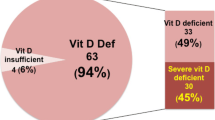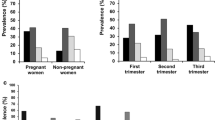Summary
Objective
To analyze the vitamin D status of pregnant women in Slovenia and the factors influencing it.
Methods
The study was performed in Maribor University Medical Centre (location 46°N). Maternal serum 25-hydroxy-vitamin D (25(OH)D) in 4 groups of 100 pregnant women in 4 different seasons of the year was measured at the time of delivery. Data on life style, eating habits, sunbathing and intake of vitamin D supplements during pregnancy were obtained using a questionnaire. Information on maternal outcome was acquired from medical records. Duration of sunlight and average temperature in the month preceding delivery were calculated from meteorological data.
Results
The average maternal 25(OH)D concentration ranged from 28.5 ± 17.1 nmol/l in March to 54.8 ± 24.1 nmol/l in June (p < 0.001). Severe vitamin D deficiency, i.e. <25 nmol/l 25(OH)D was present in 23.6% of women overall. In multiple regression analysis supplements containing vitamin D (β = 0.225, p < 0.001) and duration of intentional exposure to sunlight (β = 0.192, p = 0.026) were associated with maternal 25(OH)D status. Significantly lower vitamin D levels were observed in women who had a cesarean section (t = 2.053, p = 0.041) and those with premature delivery (t = 2.296, p = 0.022). Vitamin D levels were not associated with the occurrence of gestational diabetes, gestational hypertension or infections during pregnancy.
Conclusion
A high prevalence of vitamin D deficiency was detected at the end of pregnancy, especially in the months following autumn and winter and in women who did not take supplements containing vitamin D.


Similar content being viewed by others
References
Holick MF. Vitamin D deficiency. N Engl J Med. 2007;357(3):266–81.
Hossein-nezhad A, Holick MF. Vitamin D for health: a global perspective. Mayo Clin Proc. 2013;88(7):720–55.
Bodnar LM, Krohn MA, Simhan HN. Maternal vitamin D deficiency is associated with bacterial vaginosis in the first trimester of pregnancy. J Nutr. 2009;139(6):1157–61.
Zhang C, Qiu C, Hu FB, et al. Maternal plasma 25-hydroxyvitamin D concentrations and the risk for gestational diabetes mellitus. PLOS ONE. 2008;3(11):e3753.
Achkar M, Dodds L, Giguère Y, et al. Vitamin D status in early pregnancy and risk of preeclampsia. Am J Obstet Gynecol. 2015;212(4):511.e1–511.e7.
Merewood A, Mehta SD, Chen TC, Bauchner H, Holick MF. Association between vitamin D deficiency and primary cesarean section. J Clin Endocrinol Metab. 2009;94(3):940–5.
Scholl TO, Chen X, Stein P. Maternal vitamin D status and delivery by cesarean. Nutrients. 2012;4(4):319–30.
Karras SN, Fakhoury H, Muscogiuri G, et al. Maternal vitamin D levels during pregnancy and neonatal health: evidence to date and clinical implications. Ther Adv Musculoskelet Dis. 2016;8(4):124–35.
Baker AM, Haeri S, Camargo CA Jr, Stuebe AM, Boggess KA. First-trimester maternal vitamin D status and risk for gestational diabetes (GDM) a nested case-control study. Diabetes Metab Res Rev. 2012;28(2):164–8.
Farrant HJ, Krishnaveni GV, Hill JC, et al. Vitamin D insufficiency is common in Indian mothers but is not associated with gestational diabetes or variation in newborn size. Eur J Clin Nutr. 2009;63(5):646–52.
Milman N, Hvas AM, Bergholt T. Vitamin D status during normal pregnancy and postpartum. A longitudinal study in 141 Danish women. J Perinat Med. 2011;40(1):57–61.
Bartoszewicz Z, Kondracka A, Krasnodebska-Kiljańska M, et al. Vitamin D insufficiency in healthy pregnant women living in Warsaw. Ginekol Pol. 2013;84(5):363–7.
Vandevijvere S, Amsalkhir S, Van Oyen H, Moreno-Reyes R. High prevalence of vitamin D deficiency in pregnant women: a national cross-sectional survey. PLOS ONE. 2012;7(8):e43868.
Holmes VA, Barnes MS, Alexander HD, McFaul P, Wallace JM. Vitamin D deficiency and insufficiency in pregnant women: a longitudinal study. Br J Nutr. 2009;102(6):876–81.
Slovenian Environment Agency. ARHIV – opazovani in merjeni meteorološki podatki v Sloveniji 2014. http://meteo.arso.gov.si/met/sl/archive/. Accessed 8 October 2015.
Hollis BW, Johnson D, Hulsey TC, Ebeling M, Wagner CL. Vitamin D supplementation during pregnancy: Double-blind, randomized clinical trial of safety and effectiveness. J Bone Miner Res. 2011;26(10):2341–57.
Bjørn Jensen C, Thorne-Lyman AL, Vadgård Hansen L, et al. Development and validation of a vitamin D status prediction model in Danish pregnant women: a study of the Danish National Birth Cohort. PLOS ONE. 2013;8(1):e53059.
Mulligan ML, Felton SK, Riek AE, Bernal-Mizrachi C. Implications of vitamin D deficiency in pregnancy and lactation. Am J Obstet Gynecol. 2009;202(5):e421–e429.
Song SJ, Zhou L, Si S, et al. The high prevalence of vitamin D deficiency and its related maternal factors in pregnant women in Beijing. PLOS ONE. 2013;8(12):e85081.
Xiao JP, Zang J, Pei JJ, Xu F, Zhu Y, Liao XP. Low maternal vitamin D status during the second trimester of pregnancy: a cross-sectional study in Wuxi, China. PLOS ONE. 2015;10(2):e0117748.
Pérez-López FR, Pasupuleti V, Mezones-Holguin E, et al. Effect of vitamin D supplementation during pregnancy on maternal and neonatal outcomes: a systematic review and meta-analysis of randomized controlled trials. Fertil Steril. 2015;103(5):1278–88.
Rodda CP, Benson JE, Vincent AJ, Whitehead CL, Polykov A, Vollenhoven B. Maternal vitamin D supplementation during pregnancy prevents vitamin D deficiency in the newborn: an open-label randomized controlled trial. Clin Endocrinol (Oxf). 2015;83(3):363–8.
Sablok A, Batra A, Thariani K, et al. Supplementation of vitamin D in pregnancy and its correlation with feto-maternal outcome. Clin Endocrinol (Oxf). 2015;83(4):536–41.
Zhou J, Su L, Liu M, Liu Y, Cao X, Wang Z, et al. Associations between 25-hydroxyvitamin D levels and pregnancy outcomes: a prospective observational study in southern China. Eur J Clin Nutr. 2014;68(8):925–30.
Bodnar LM, Rouse DJ, Momirova V, Peaceman AM, Sciscione A, Spong CY, et al. Eunice Kennedy Shriver National Institute of Child Health and Human Development (NICHD) Maternal-Fetal Medicine Units (MFMU) Network. Maternal 25-hydroxyvitamin D and preterm birth in twin gestations. Obstet Gynecol. 2013;122(1):91–8.
Baker AM, Haeri S, Camargo CA Jr, Stuebe AM, Boggess KA. A nested case-control study of first-trimester maternal vitamin D status and risk for spontaneous preterm birth. Am J Perinatol. 2011;28(9):667–72.
Robinson S, Nelson-Piercy C, Harvey NC, Selby P, Warner JO. Vitamin D in pregnancy. Scientific Impact Paper No. 43. London: Royal College of Obstetricians and Gynaecologists 2014. https://www.rcog.org.uk/globalassets/documents/guidelines/scientific-impact-papers/vitamin_d_sip43_june14.pdf. Accessed 1 November 2015.
Marshall I, Mehta R, Petrova A. Vitamin D in the maternal-fetal-neonatal interface: clinical implications and requirements for supplementation. J Matern Fetal Neonatal Med. 2013;26(7):633–8.
Koletzko B, Bauer CP, Bung P, et al. German national consensus recommendations on nutrition and lifestyle in pregnancy by the ‘Healthy Start – Young Family Network. Ann Nutr Metab. 2013;63(4):311–22.
Canadian Pediatric Society. Vitamin D supplementation: recommendations for Canadian mothers and infants. Paediatr Child Health. 2007;12(7):583–98.
Wu BT, Dyer RA, King DJ, Innis SM. Low fish intake is associated with low blood concentrations of vitamin D, choline and n‑3 DHA in pregnant women. Br J Nutr. 2013;109(5):936–43.
Oken E, Kleinman KP, Berland WE, Simon SR, Rich-Edwards JW, Gillman MW. Decline in fish consumption among pregnant women after a national mercury advisory. Obstet Gynecol. 2003;102(2):346–51.
Coletta JM, Bell SJ, Roman AS. Omega-3 fatty acids and pregnancy. Rev Obstet Gynecol. 2010;3(4):163–71.
Acknowledgements
The study was funded by University Medical Center Maribor and the University of Maribor with co-funding by the European Regional Development Fund.
Author information
Authors and Affiliations
Corresponding author
Ethics declarations
Conflict of interest
A. Dovnik, F. Mujezinović, M. Treiber, B. Pečovnik Balon, M. Gorenjak, U. Maver, and I. Takač declare that they have no competing interests.
Rights and permissions
About this article
Cite this article
Dovnik, A., Mujezinović, F., Treiber, M. et al. Determinants of maternal vitamin D concentrations in Slovenia. Wien Klin Wochenschr 129, 21–28 (2017). https://doi.org/10.1007/s00508-016-1142-2
Received:
Accepted:
Published:
Issue Date:
DOI: https://doi.org/10.1007/s00508-016-1142-2




